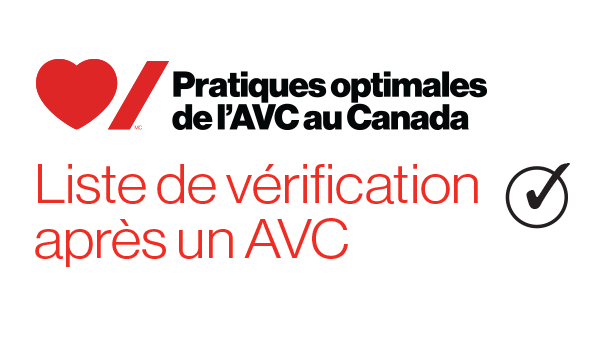- Définitions
- Éléments fondamentaux des services de prévention de l’AVC
- 1. Triage et évaluation diagnostique initiale de l’accident ischémique transitoire (AIT) et de l’AVC non invalidant
- 2. Prise en charge du mode de vie et des facteurs de risque
- 3. Pression artérielle et prévention de l’AVC
- 4. Prise en charge des lipides
- 5. Prise en charge du diabète et de l’AVC
- 6. Traitement antiplaquettaire des cas d’AVC ischémique et d’AIT
- 7. Traitement anticoagulant visant la fibrillation auriculaire
- 8. Prise en charge périopératoire du traitement anticoagulant et du traitement antiplaquettaire
- 9. Prise en charge de la maladie artérielle carotidienne extracrânienne et de l’athérosclérose intracrânienne
- 10. Problèmes cardiaques concomitants chez les personnes ayant subi un AVC
- 11. AVC ischémique associé au cancer
Recommandations
Remarque : Ces recommandations de prévention secondaire s’appliquent à l’AIT et à l’AVC d’origine ischémique et hémorragique, sauf indication contraire.
3.0 Pression artérielle
Il faut évaluer et prendre en charge la pression artérielle chez toutes les personnes ayant subi un AVC ou un AIT [niveau de preuve A].
3.1 Mesure de la pression artérielle
- Toutes les personnes à risque d’AVC récidivant devraient faire évaluer leur pression artérielle de manière régulière [niveau de preuve A], au moins une fois par an, et plus souvent selon les circonstances cliniques individuelles [niveau de preuve C].
- Pour la mesure de la pression artérielle initiale et subséquente, il faut suivre les techniques normalisées appropriées préconisées par les Lignes directrices d’Hypertension Canada, que ce soit en clinique, à la maison ou en milieu communautaire [niveau de preuve B]. Voir les Lignes directrices d’Hypertension Canada et les protocoles concernant la mesure de la pression artérielle actuels (http://guidelines.hypertension.ca/).
- Les patients dont la pression artérielle au repos mesurée de façon automatisée est élevée (systolique >135 mm Hg et/ou diastolique >85 mm Hg) devraient subir une évaluation plus approfondie afin de confirmer le diagnostic d’hypertension [niveau de preuve C].
- Pendant une visite d’évaluation de l’hypertension, envisager de prendre la moyenne de trois mesures de la pression artérielle, conformément aux lignes directrices les plus récentes d’Hypertension Canada [niveau de preuve C]. Voir l’algorithme d’Hypertension Canada pour le diagnostic de l’hypertension, y compris les cibles de surveillance de la pression artérielle à domicile.
- Les patients atteints d’hypertension réfractaire devraient être examinés de manière exhaustive afin de déterminer les causes secondaires de l’hypertension [niveau de preuve B].
- Les patients qui souffrent d’hypertension ou à risque d’en souffrir (considérés comme en préhypertension ou en présence d’autres facteurs de risque) devraient recevoir des conseils et des interventions importantes ciblant la modification des facteurs de risque et du mode de vie [niveau de preuve B]. Pour plus de précisions, voir les recommandations de la partie 2 sur la prise en charge du mode de vie, notamment en ce qui a trait à l’apport en sodium et à l’alimentation saine et équilibrée.
3.2 Prise en charge de la pression artérielle
- Il convient d’examiner attentivement l’initiation d’un traitement antihypertenseur après la phase aiguë d’un AVC ou d’un AIT [niveau de preuve A].
- Pour les patients qui ont été victimes d’un AVC ischémique ou d’un AIT, un traitement visant à baisser la pression artérielle est recommandé, ciblant une pression artérielle constamment inférieure à 140/90 mm Hg [niveau de preuve B]; ce traitement est aussi recommandé pour les personnes atteintes de néphropathie chronique.
- Pour les patients ayant subi un léger AVC sous-cortical (p. ex., un AVC lacunaire), il est raisonnable d’administrer un traitement vigoureux visant à baisser la pression artérielle afin d’obtenir une pression artérielle systolique constamment inférieure à 130 mm Hg [niveau de preuve B].
- Chez les patients victimes d’une hémorragie intracérébrale, la pression artérielle devrait être surveillée, traitée et maîtrisée de manière vigoureuse [niveau de preuve A] pour maintenir une pression artérielle cible constamment inférieure à 130/80 mm Hg [niveau de preuve B]. Voir les Recommandations canadiennes pour les pratiques optimales de soins de l’AVC : Chapitre la prise en charge de l’hémorragie intracérébrale.
- Pour prévenir un premier AVC ou un AVC récidivant chez les patients atteints de diabète et ayant subi un AVC, un traitement visant à baisser la pression artérielle est recommandé, ciblant une pression artérielle systolique constamment inférieure à 130 mm Hg [niveau de preuve C] et une pression artérielle diastolique constamment inférieure à 80 mm Hg [niveau de preuve A].
- Les essais cliniques comparatifs sur échantillon aléatoire n’ont pas permis de déterminer le moment idéal pour amorcer un traitement en vue de baisser la pression artérielle après un AVC aigu ou un AIT. Il est recommandé d’amorcer un tel traitement ou d’y apporter des modifications avant le congé de l’hôpital [niveau de preuve B]. Voir les recommandations de la partie 3.3 du chapitre sur les soins en phase hyperaiguë pour la prise en charge de la pression artérielle durant la phase aiguë de l’AVC (0-72 h).
- Il est recommandé d’amorcer un traitement à l’aide de la combinaison d’un IECA et de diurétiques thiazidiques ou d’autres diurétiques similaires [niveau de preuve A]. Les diurétiques à action prolongée peuvent être considérés comme préférables aux diurétiques à durée d’action courte [niveau de preuve B]. *
- L’utilisation d’un IECA combiné à un ARA n’est pas recommandée [niveau de preuve B]. *
- Les patients qui ne reçoivent pas de traitement antihypertenseur pendant les soins actifs devraient obtenir une consultation de suivi en soins primaires ou en service de prévention de l’AVC pour les besoins de l’évaluation et de la prise en charge continues [niveau de preuve C]. Remarque : La prise en charge de la pression artérielle est la responsabilité de tous les membres de l’équipe soignante. Les patients qui ont subi un AVC auront peut-être besoin initialement d’une surveillance fréquente (p. ex., mensuelle), jusqu’à ce que leur pression artérielle atteigne la valeur cible et qu’un traitement optimal ait été défini.
Remarques : * Pour prendre connaissance des recommandations sur des agents ou séquences d’agents précis en matière de prise en charge de la pression artérielle pour la prévention secondaire de l’AVC ischémique, veuillez consulter les plus récentes lignes directrices d’Hypertension Canada sur le traitement (anglais uniquement).
Facteurs cliniques
- (Nouveau en 2020) Chez les patients présentant une sténose artérielle intracrânienne ou extracrânienne critique non revascularisée et qui présentent des symptômes neurologiques attribués à une ischémie cérébrale ou rétinienne hémodynamique (faible débit) (p. ex., AIT orthostatiques), il est raisonnable de viser des cibles de pression artérielle plus élevées que d’habitude (c.-à-d. hypertension permissive) et d’éviter l’hypotension pour prévenir l’AVC hémodynamique; si ces patients sont asymptomatiques, il faut suivre les cibles habituelles de pression artérielle dans la phase post-aiguë de l’AVC
La pression artérielle élevée représente le plus important facteur de risque de l’AVC. Chez un adulte sur cinq au pays, la pression artérielle se situe dans l’intervalle de 130-139/85-89 mm Hg (que certains chercheurs qualifient d’intervalle de « préhypertension »); parmi eux, jusqu’à 60 % souffriront d’hypertension en moins de 4 ans. Parmi ceux qui ont au moins 55 ans et dont la pression artérielle est normale, 90 % souffriront d’hypertension s’ils ont une durée de vie dans la moyenne. Tous les adultes ont besoin d’un suivi régulier de la pression artérielle tout au long de leur vie. Chaque augmentation de 1 mm Hg de la pression artérielle augmente d’environ 1 % le risque d’une piètre fonction cognitive à un âge plus avancé. Des études épidémiologiques révèlent que le risque d’AVC augmente de façon proportionnelle à la pression artérielle.
Le fait que la pression artérielle élevée est un important risque d’un premier AVC ou d’une récidive est démontré par de nombreuses études de population; l’hypertension serait responsable d’environ 60 % du risque attribuable aux maladies vasculaires cérébrales pour une population donnée. L’essai Interstroke a signalé un coefficient de probabilité de 2,64 chez les patients qui souffrent d’hypertension et sont victimes d’un AVC. Plusieurs essais cliniques ont établi à 28 % la baisse du risque de récidive de l’AVC lorsque les patients suivent un traitement antihypertenseur. Chez les personnes ayant déjà subi un AVC, le risque de récidive a été réduit considérablement grâce à un traitement antihypertenseur intensif. Le NST était de 67 (Kitagawa et coll., 2019).
Les essais cliniques comparatifs sur échantillon aléatoire n’ont pas permis de déterminer une pression artérielle optimale pour les patients victimes d’un AVC et les patients à risque d’AVC. La recommandation actuelle est de traiter le patient victime d’un épisode vasculaire cérébral en ciblant une pression artérielle constamment inférieure à 140/90 mm Hg. Les données épidémiologiques disponibles indiquent que les patients chez lesquels le traitement antihypertenseur est efficace en obtenant des valeurs constamment inférieures à 140/90 mm Hg obtiennent de meilleurs résultats de santé. Aucun des essais thérapeutiques n’a toutefois permis de déterminer jusqu’à quelles valeurs la pression artérielle devrait être baissée.
Les personnes qui ont subi un AVC ont signalé un manque de sensibilisation ou d’attention aux mesures de la pression artérielle avant leur AVC. Ils insistent sur le fait que l’éducation sur la prise en charge de la pression artérielle est une partie essentielle des soins, mais ils soulignent également que l’ampleur de l’effet d’une pression artérielle élevée sur le risque de subir un second AVC ne leur a pas été expliquée clairement. Les équipes de prise en charge de l’AVC et les autres dispensateurs de soins ont l’occasion d’améliorer la sensibilisation et la prise en charge de la pression artérielle et de fournir aux personnes ayant subi un AVC les connaissances, les mesures et les outils de suivi et d’enregistrement dont elles ont besoin pour atténuer les risques futurs.
- Programmes concertés de sensibilisation à l’hypertension aux échelons provincial et communautaire auxquels participent les groupes communautaires, les dispensateurs de soins primaires (y compris les médecins, les infirmières praticiennes et les pharmaciens) et les autres partenaires pertinents
- Approches de prévention de l’AVC, y compris la surveillance de la pression artérielle, adoptées par les dispensateurs de soins primaires dans la communauté pour la prise en charge globale du patient
- Disponibilité et facilité d’accès accrues à des programmes de formation sur le diagnostic et la prise en charge de l’hypertension chez les adultes et les enfants pour les dispensateurs de soins de santé à toutes les étapes du continuum des soins
- Soutien accru à l’usage des dispositifs de surveillance à domicile de la pression artérielle (programmes ou crédits d’impôt) pour les patients, leur famille et les programmes d’autogestion de l’hypertension.
- Accès universel et équitable à des médicaments efficaces et peu coûteux pour tous les habitants du pays, sans égard à la géographie, à l’âge ou à la capacité de payer.
- Proportion des personnes à risque d’AVC dont la pression artérielle a été surveillée lors de la dernière consultation médicale ; et dans les 12 derniers mois.
- Proportion de la population pour laquelle on a établi un diagnostic de pression artérielle élevée (hypertension).
- Proportion de la population sensibilisée à l’hypertension et à ses risques.
- Pourcentage de la population dont l’hypertension est établie et qui suit un traitement antihypertenseur.
- Proportion de la population qui souffre d’hypertension, suit un traitement et a atteint la cible thérapeutique déterminée (selon les lignes directrices du PÉCH) par une modification des habitudes de vie et/ou des médicaments.
- Proportion des patients avec AVC ou AIT auxquels on a prescrit un agent antihypertenseur et qui ne reçoivent plus de soins actifs.
- Proportion des patients avec AVC ou AIT auxquels on a prescrit un agent antihypertenseur après une évaluation dans une clinique de prévention secondaire de l’AVC.
Notes sur la mesure des indicateurs
- Indicateurs de rendement 1 à 3 : Données pouvant provenir de la banque de données du PÉCH, de l’Enquête sur la santé des collectivités canadiennes (Statistique Canada), des sondages provinciaux et locaux et de déclarations volontaires des patients.
- Indicateurs de rendement 4 : données pouvant provenir de la vérification des dossiers des patients auprès des fournisseurs de soins primaires. Les données sur les ordonnances peuvent provenir des banques de données des régimes d’assurance-maladie, bien que ceux-ci peuvent être limités selon l’âge des assurés et il y a une variation selon les provinces et territoires.
- Indicateurs de rendement 7 : Les ordonnances d’agents antihypertenseurs peuvent être rédigées durant le séjour à l’hôpital ou pendant une évaluation de prévention secondaire et de suivi. Il est important de noter le cadre dans lequel le traitement a été amorcé. Sources de données : Ordonnances des patients et ordonnances médicales, notes des médecins et du personnel infirmier, résumés produits au moment du congé ou copies des ordonnances données aux patients.
- Une ordonnance donnée à un patient ne veut pas dire qu’elle est observée.
- Les algorithmes permettant de déterminer l’incidence et la prévalence de l’hypertension à partir des banques de données administratives ont été validés au Canada et devraient être utilisés dans la mesure du possible afin d’assurer la cohérence des mesures104.
Renseignements destinés aux dispensateurs de soins de santé
- Ressources de Cœur + AVC sur la pression artérielle
-
Lignes directrices d’Hypertension Canada (en anglais seulement)
Informations destinées au patient
-
Cœur + AVC – Carte portefeuille pour noter la pression artérielle
-
Ressources sur l’hypertension au Canada : y compris :
-
Hypertension : ce que vous devez savoir – À propos de l’hypertension et Traitement de l’hypertension
-
Hypertension : Comment puis-je intervenir?
-
Mesure de la pression artérielle à domicile – Carnet de suivi – mesurez et consignez régulièrement votre pression artérielle grâce à ce carnet de suivi.
-
Pression artérielle – Plan d’action – conseils pour créer un plan d’action afin de maintenir votre pression artérielle à des valeurs saines.
-
Blood Pressure and Stroke Prevention Evidence Tables and Reference List
Stroke Risk and Hypertension
Hypertension is widely regarded as the most important modifiable risk factor for stroke. Results from phases 1 and 2 of the INTERSTROKE study (O’Donnell et al. 2010, O’Donnell et al. 2016), indicated that among the five risk factors that accounted for more than 80% of the risk for stroke, hypertension was found to be most significant. The others included current smoking, abdominal obesity, diet, and physical activity. In phase 1 of the study, a self-reported history of hypertension or measured blood pressure ≥160/90 mm Hg was associated with an increased risk of all stroke (OR=2.98, 99% CI 2.72-3.28), but was highest for hemorrhagic stroke (OR=9.18, 99% CI 6.80-12.39). The same risk pattern was reported in phase 2 of the study, which used a self-reported history of hypertension or measured blood pressure ≥140/90 mm Hg to define hypertension (O’Donnell et al. 2016). The risk of hemorrhagic stroke was significantly increased (OR=4.09, 99% CI 3.51-4.77). In another case-control study, Du et al. (2000) reported the risk of stroke was significantly higher among subjects who were hypertensive (OR=2.45, 95% CI 1.62 to 3.71, p< 0.001) and the risk of stroke increased with additional risk factors including smoking and diabetes. The authors suggested that at least three-quarters of strokes in hypertensive patients are preventable given appropriate treatment. The authors further emphasized that strokes are caused not by a single risk factor, but by the interaction of multiple risk factors, with some having a stronger independent relationship with stroke than others. A meta-analysis (Lewington et al. 2002) that included the results of one million adults from 61 prospective studies found that an increase of 20 mm Hg in systolic and 10 mm Hg in diastolic blood pressure led to a two-fold increase in stroke mortality in persons aged 40 – 69 years, without any evidence of a threshold down to at least 115/75 mm Hg for all vascular deaths. Age-specific associations were found to be similar for men and women, and for cerebral hemorrhage and cerebral ischemia. Data from 1.25 million people without a history of cardiovascular disease, included in the CALIBER database were used to estimate lifetime risks and years of life lost to cardiovascular disease (Rapsomanki et al. 2014). During a median follow-up of 5.2 years, for each 20/10 mm Hg increase, the risks of transient ischemic attack, ischemic stroke and ICH increased across age cohorts (30-59, 60-79 and ≥80 years), with the highest risks noted in the youngest patients. The lifetime risk of ischemic stroke (from index age of 30 years) in persons with hypertension, defined as ≥140/90 mm Hg, was 7.6% (95% CI 7.3%-7.8%) compared with 6.5% (95% CI 6.2%-6.9%) for persons without hypertension. The years of life lost to ischemic stroke for those with hypertension was approximately a half a year.
Pharmacological Treatment of Hypertension Reduces Stroke Risk
Among persons who sustained an acute stroke, antihypertensive treatment, initiated within 48 hours of the event was shown to significantly reduce the risk of recurrent stroke at >12 months, compared with placebo or no treatment (RR=0.81, 95% CI 0.70-0.93). The effect was most pronounced for persons with baseline SBP>140 mm Hg. ACE inhibitors and diuretics were found to be the most effective antihypertensive agents (Zonneveld et al. 2018). The risks of recurrent stroke, disabling or fatal stroke and cardiovascular death were all significantly reduced following antihypertensive treatment compared with placebo in a systematic review including 14 RCTs (Katsanos et al. 2017). In meta-regression analysis, increasingly lower SBP was linearly associated with significant reductions in recurrent stroke, MI, death from any cause and cardiovascular death. Several meta-analyses included trials with persons both with and without previous stroke. Intensive blood pressure treatment was shown to decrease the risk of recurrent stroke compared with less intensive treatment by 22% (HR=0·78, 95% CI 0·67–0·90, p=0·001), after a mean duration of follow-up of 3.8 years (Xie et al. 2016, n=19 trials). Bangalore et al. (2017) included trials comparing different goal systolic blood pressure (SBP) targets (<150, <140, <130 and <120 mm Hg) against a reference standard of <160 mm Hg. The risk of stroke was decreased in a comparison of target SBP <120 vs. <160 mm Hg, the reference standard (RR=0.54, 95% CI 0.29-1.00), but there were no significant reductions in risk for any of the other pairings (<150 vs. <160 mm Hg; <140 vs. <160 mm Hg; <130 vs. <160 mm Hg). Looking from a different perspective, compared with a target SBP of <120 mm Hg, the risk of stroke was significantly increased with SBP <140 mm Hg (RR=1.72, 95% CI 1.42-2.58), <150 mm Hg (RR=1.97, 95% CI 1.26-3.08) and <160 mm Hg (RR=3.27, 95% CI 1.78-6.00). The authors suggested that SBP targets of <120 and <130 mm Hg were best for stroke prevention. Ettehad et al. (2016) included the results of 123 RCTs examining persons with and without previous stroke or transient ischemic attack. The risk of major cardiovascular events was reduced significantly for each 10 mm Hg reduction in SBP (RR= 0·80, 95% CI 0·77–0·83), including stroke (RR=0·73, 95% CI 0·68–0·77), with the magnitude of risk reduction proportional to the blood pressure reduction achieved. The risk of stroke was reduced significantly per each 10 mm Hg decrease in SBP with antihypertensive treatment in persons with and without existing cardiovascular disease (RR=0·74, 95% CI 0.67-0.81 and RR=0·75, 95% CI 0.63-0.89, respectively). The most effective antihypertensive agents for the reduction in stroke risk were angiotensin receptor blockers and calcium channel blockers. Beta-blockers were inferior to other classes of antihypertensives. The risk of stroke was reduced with antihypertensive treatment across different 10 mm Hg strata of baseline SBP ≥130. Lee et al. (2012) included the results of 11 RCTs representing data from 42,572 participants (794 with previous stroke) who were at high risk for cardiovascular disease and compared treatment of tight blood pressure control (SBP <130 mm Hg) with usual control (SBP 130 to 139 mm Hg) on subsequent stroke risk. Tight SBP target was associated with reduced risks of future stroke, and major vascular events, and major coronary events, but was not associated with a significantly lower risk of death. Among patients with diabetes, those without a history of CVD, and younger than 65 years experienced the greatest stroke risk reduction.
A recent clinical trial (RESPECT) compared standard blood pressure treatment, with a target of <140/90mm Hg, with intensive treatment target of <120/80 mm Hg, among 1,280 patients with a stroke sustained within the previous 30 days to 3 years with a baseline SBP of 130 to 180 mm Hg or DBP of 80 to 110 mm Hg. Unfortunately, the trial was stopped prematurely, before planned recruitment of 2,000 participants (Kitagawa et al. 2019). After a mean duration of follow-up of 3.8 years, there were 52 strokes (2.26% per year) in the standard group and 39 (1.65% per year) in the intensive group. The risk of recurrent stroke was not reduced significantly with intensive BP treatment (HR=0.73, 95% CI 0.49-1.11, p=0.15). The Secondary Prevention of Small Subcortical Strokes (SPS3 Trial) examined the effectiveness of medical management to reduce recurrent stroke in persons with a lacunar stroke, sustained within the previous 180 days. Lowering systolic blood pressure (SBP) to a target of < 130 mm Hg resulted in a non-significant reduction on all stroke, disabling stroke, myocardial infarction and vascular death compared with target SBP levels of 130-149 mm Hg (Benavente et al. 2013).
Lower blood pressure targets (<130/80 mm Hg) have been recommended for persons with diabetes for the prevention of first or recurrent stroke. A Cochrane review (Arguedas et al. 2013) included the results from 5 RCTs comparing ‘lower’ blood pressure targets (any target <130/85mm Hg) with ’standard’ targets (<140-160/90-100 mm Hg). Participants were adults with type 2 diabetes and elevated blood pressure, or already receiving treatment for elevated blood pressure. In the single included trial, which aimed at reductions in systolic blood pressure (ACCORD 2010) intensive BP control was not associated with reductions in total mortality (RR= 1.05, 95% CI 0.84-1.30) but was associated with reduction in the risk of stroke (RR=0.58, 95% CI 0.39 to 0.88, p= 0.009); however, serious adverse events, attributed to therapy occurred more often in patients in the intensive group (3.3% vs. 1.3%, p<0.001). In the 4 trials aimed at reductions in diastolic blood pressure, intensive BP control was not associated with reductions in total mortality (RR= 0.73, 95% CI 0.53-1.01, p=0.054) or stroke (RR= 0.67, 95% CI 0.42-1.05, p=0.077). In the UKPDS (Turner et al. 1988), the risk of fatal and nonfatal stroke (combined) was reduced by 44% (HR= RR=0.56, 95% CI 0.35-0.89, p=0.013) among patients in the tight BP control (mean BP achieved 144/82 mm Hg) compared with less aggressive control (mean BP achieved 154/87 mm Hg).
Sex and Gender Considerations
The evidence is conflicting regarding the increased risk of ischemic stroke associated with hypertension according to sex. There was no indication to suggest a sex difference in the relationship between systolic blood pressure (SBP) and the risk of stroke in a large meta-analysis including 124 studies (Peters et al. 2013) or from the CALIBER study including over 1.25 million persons (Rapsomaniki et al. 2014). In one of the REGARDS publications (Madsen et al. 2019), which included data from 26,461 participants, the risk of stroke was increased significantly more per each 10 mm Hg increase in SBP in women (HR=1.15, 95% CI, 1.10–1.20 vs. HR=1.08, 95% CI, 1.03–1.14, p for interaction=0.09).
Control of hypertension was found to be significantly higher among women <60 years compared with men (56.3% vs. 50.6%); but was lower among women aged ≥60 years (50.8% for women vs. 54.6% for men, p<0.05) (Yoon et al. 2015). Although not statistically significant, intensive blood pressure lowering was found to reduce the risk of major cardiovascular events, including stroke, more in men compared with women in a sub analysis of the SPRINT trial (HR=0.84, 95% CI 0.61–1.13 vs. HR=0.73, 95% CI 0.59–0.89, p value for interaction=0.45) (Foy et al. 2018).






